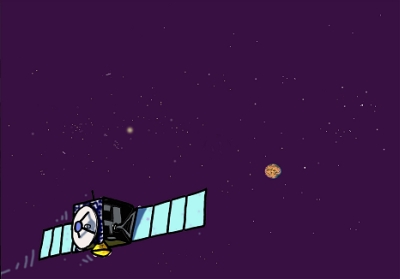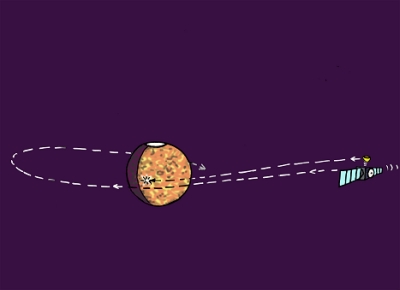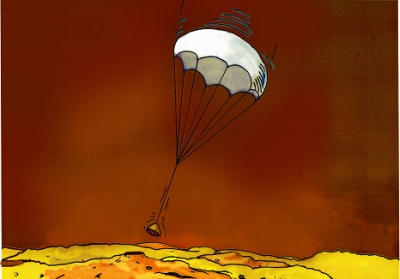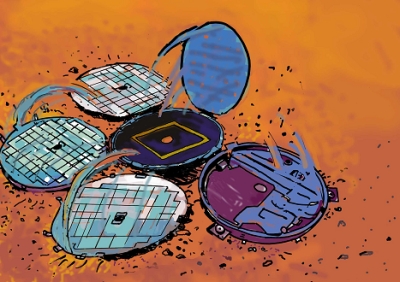The Story of Mars Express
Slide 1
 |
|
All young people are all very curious about Mars and always wanted to know what this neighboring planet will reveal. As the planets move around the Sun in orbits, it just happens that in 2003 Mars is very close to the Earth! This is a fantastic occasion to send an unmanned mission to know more about the red planet surface, subsurface, atmosphere, and in particular how much water there is on Mars, and if there ever was life there. To find out ESA is sending to Mars an orbiter called Mars Express and a lander called Beagle 2. |
Slide 2
 |
|
The European journey started with a lot of noise on the night of the 2 June from Baikonur in Kazakhstan with the launch of a Soyuz rocket carrying Mars Express, ESA's unmanned traveler to Mars |
Slide 3
 |
|
A few seconds after launch, when the air outside gets thin, the two shells of the fairing protecting Mars Express open, revealing the precious cargo inside. |
Slide 4
 |
|
The engine from Fregat provides a last push to make Mars Express escape the attraction of the Earth's gravity. |
Slide 5
 |
|
When the work of the Fregat engine is finished, Mars Express separates and deploys the solar panels to start a life on its own. |
Slide 6
 |
|
Mars Express is now on its way to Mars on a long journey that will last almost seven months. During this time it will be controlled and monitored by the team of scientists and engineers at the Mission Control Centre in Darmstadt, Germany, that maintains radio control with the spaceship. |
Slide 7
 |
|
Five days before reaching Mars, Mars Express releases the capsule containing Beagle 2, the robot that will land in Isidis Planitia in the Northern hemisphere near the equator of Mars. With a light spin the capsule separates from Mars Express and continues alone the last part of the journey to Mars. |
Slide 8
 |
|
After releasing Beagle 2, Mars Express fires its little engines and adjusts slightly his trajectory to avoid collision with Mars. |
Slide 9
 |
|
The trajectory of Mars Express is such that it is slowed down by the mass of Mars and captured in an elliptical orbit around the equator of planet. The initial orbit is highly elliptical with a duration of around 14 days, but it will slowly drift over a period of a couple of weeks until the orbit becomes polar. Mars Express passes regularly over the poles of Mars and the rotation of the planet around its poles allows to slowly explore all the surface of the planet. |
Slide 10
 |
|
Something like a comet is seen over the sky in Mars! |
Slide 11
 |
|
The friction of the atmosphere heats the protective shield of the capsule, and Beagle 2 is slowed down in its velocity as it plunges into the thin orange atmosphere of Mars. |
Slide 12
 |
|
A white nylon parachute makes the final descent possible for Beagle 2, before touching down! |
Slide 13
 |
|
Bang! |
Slide 14
 |
|
Then the three airbags are released and... boom! The 30 kg disc inside is dropped. The Beagle 2 has landed! |
Slide 15
 |
|
The light shell of carbon fibre and aluminum honeycomb opens up, deploying 4 solar panels that will provide the necessary power to charge the lander batteries, providing the energy to perform all the activities of the robot. |
Slide 16
 |
|
Once the dust produced by the landing settles down, the robot raises its head called PAW and starts looking around inspecting the landing area with the stereoscopic camera. |
Slide 17
 |
|
Beagle 2 has a small antenna enough to communicate with Mars Express when the orbiter passes over the area. The Orbiter stores the information from Beagle 2 for later transmission to the Earth. |
Slide 18
 |
|
When Mars Express is in the higher part of its orbit it stops observing the surface of Mars and reorients itself so that its powerful antenna points towards the Earth. Then it starts transmitting the valuable data to the scientists who are anxiously waiting for fresh news from the Red Planet. |
Slide 19
 |
|
In the meantime the PAW from Beagle 2 acquires 360º panoramic images, looking for the best place to dig and explore within reach of the robotic arm, a good rock for instance. |
Slide 20
 |
|
A little drill called Grinder helps remove the dust layer on the surface and the weathering rind on rocks to expose the interesting material. The Mole (also called Pluto) is sent lurching to dig in the surface as far as 2 meters distance, penetrating beneath the dusty surface to find the harder material beneath. The rhythmic displacement of a mass inside acts as a hammer forcing the Mole to go deeper. |
Slide 21
 |
|
The Robotic arm helps to place the Mole's mouth over the opening of a little but powerful laboratory. Then the pray is released and the samples are analyzed by the Gas Analysis Package including a mass spectrometer, looking for organic matter and water inside. |
Slide 22
 |
|
During the low attitude passes in the orbit, Mars Express continues to explore the planet mapping the surface of Mars and analyzing the atmosphere with many instruments, for example with OMEGA, an infrared spectrometer, it maps the mineralogical composition of the surface. |
Slide 23
 |
|
The Super High Resolution Stereo Colour Imager instrument (HRSC) acquires very detailed 3D images of the surface of the planet, that will also allow to determine the height of mountains and the relative ages of the planet's surface. |
Slide 24
 |
|
Mars Express deploys three very long antennae, made of fiberglass, that were folded inside a box. The antennae have a span of 40 meters. The large antennae of the Marsis radar send low frequency signals that go deep inside the surface of Mars (down to 5Km) looking for signs of water (or ice) when the signals are reflected back into the Orbiter's radar. |
Slide 25
 |
|
Mars Express also analyses the atmosphere of Mars in detail. With the Planetary Fourier Spectrometer (PFS) it gives a 3D map of the atmospheric temperatures of the areas it passes by and determines the components of the atmosphere. SPICAM comprises as Infrared and Ultraviolet spectrometer that measures vertical temperatures, water and ozone in the atmosphere. The measurements of Mars Express will go on for 2 Martian years (about 4 terrestrial years), slowly discovering the planet as it rotates under the orbit of our traveller. |
